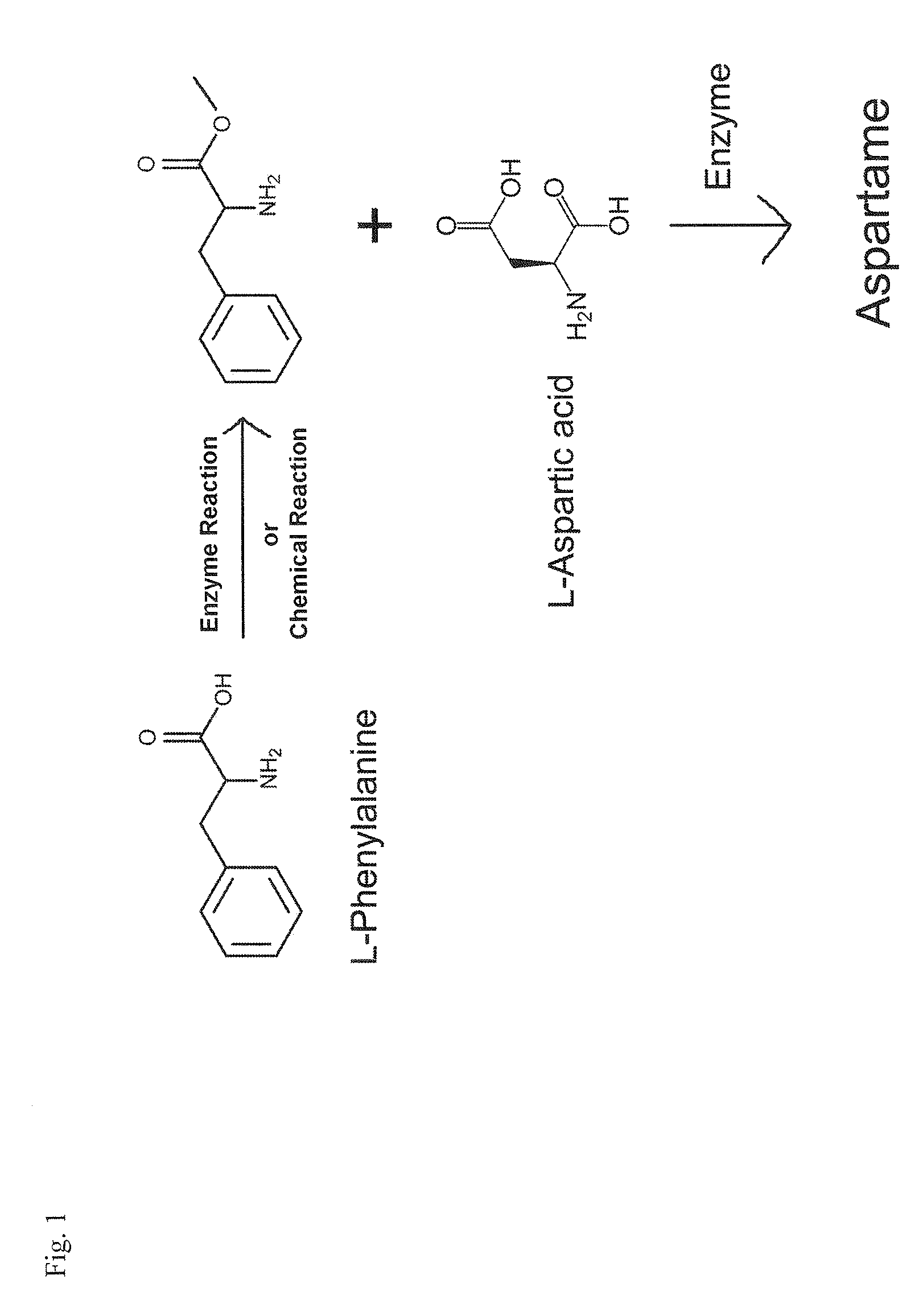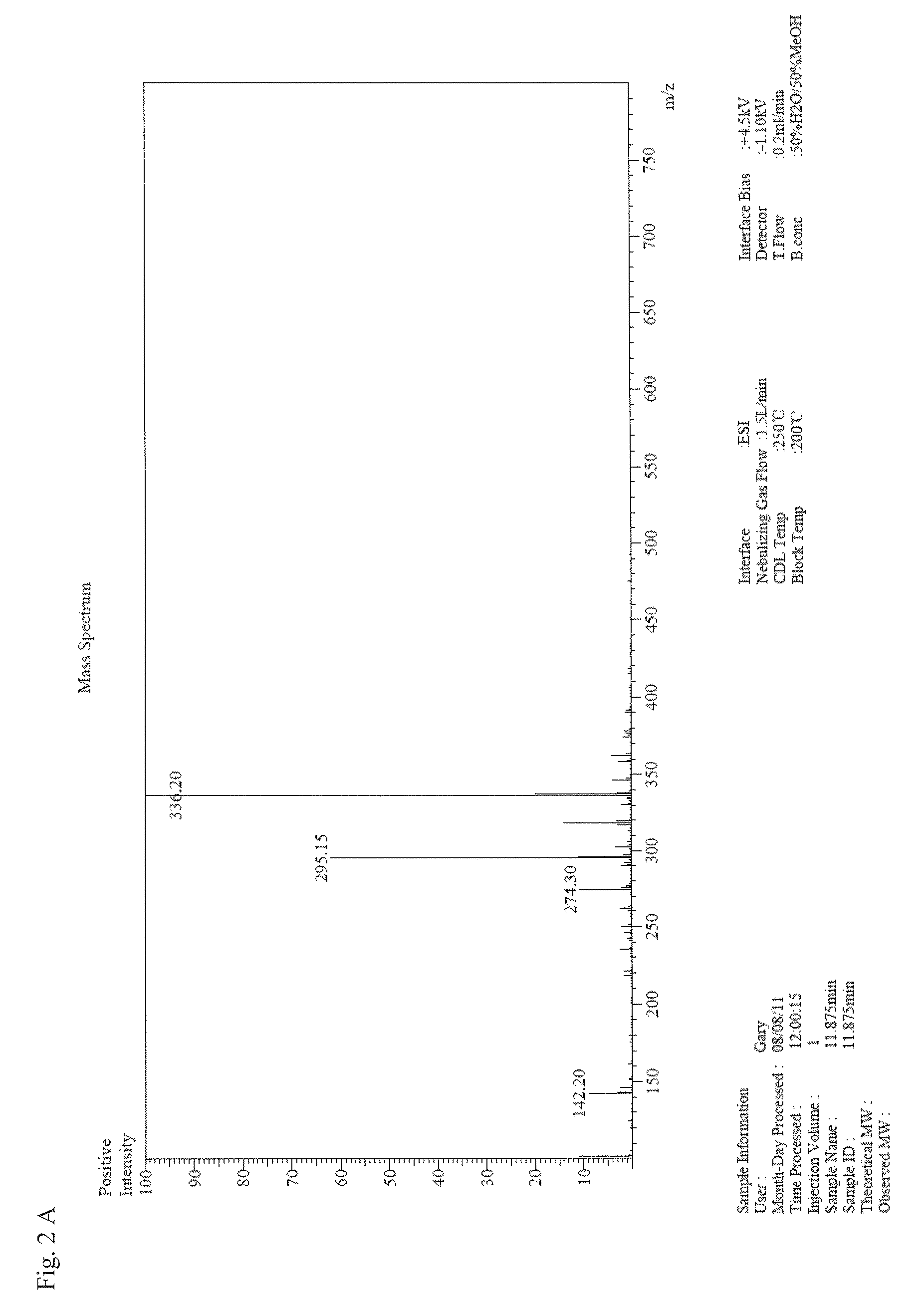Enzymatic method for preparing aspartam
a technology of aspartame and enzymology, which is applied in the field of improving the enzymatic method for the synthesis of aspartame, can solve the problems of increasing the production cost significantly, affecting the yield of aspartame, and affecting the quality of aspartame, so as to achieve the effect of high yield
- Summary
- Abstract
- Description
- Claims
- Application Information
AI Technical Summary
Benefits of technology
Problems solved by technology
Method used
Image
Examples
example 1
Preparation of Crude Enzyme Powder of PT121 Protease
[0086]The PT121 strain isolate described in Tang et al. (2008) was used for the preparation of crude enzyme powder of PT121 protease. The PT121 isolate was characterized to belong to Pseudomonas genus and showed high degree of similarity (>98%) to Pseudomonas aeruginosa by 16S rRNA analysis.
[0087]The PT121 isolate was grown in the following medium:
[0088]Tryptone 10 g / L
[0089](NH4)SO4 4 1.0 g / L
[0090]KH2PO4 0.5 g / L
[0091]MgSO4 0.3 g / L
[0092]CaCl2 1.0 g / L
[0093]NaCl 1.0 g / L
[0094]Glycerol 6.3 g / L
[0095]pH 7.0
[0096]The strain was cultured by shaking at 37° C. at 180 rpm for 72 hour (h). The culture was centrifuged at 10,000 rpm for 15 min at 4° C. The supernatant was separated and defined as crude enzyme solution. The crude enzyme solution was lyophilized to make the crude enzyme powder.
example 2
The Effect of Organic Solvent Concentration on APM Yield
[0097]Different concentrations of organic solvent were included in reaction mixtures to study the effect of organic solvent concentration on the yield of aspartame (APM yield).
[0098]The synthesis of aspartame was carried out using L-Asp and methyl L-Phe (L-Phe-OMe) as substrates with 15 mg crude enzyme power: 30 mM L-Asp was used with 344 mM L-Phe-OMe in a 10 ml reaction mixture. The reaction was performed in 0.1M sodium Tris-HCl buffer solution at pH 4.0 with 0%, 15%, 30%, 60% or 70% DMSO, by volume, and was incubated at 37° C. overnight (15 h).
[0099]The yields of APM are listed in Table 1:
DMSO (v / v)APM yield (mg / ml)0%015%030%0.2660%1.0470%0.37
example 3
The Effect of Substrate Concentration on APM Yield
[0100]Different concentrations of L-Asp were included in reaction mixtures with mixed amount of L-Phe-OMe to study the effect of substrate concentration on the APM yield.
[0101]The synthesis of aspartame was carried out using L-Asp and L-Phe-OMe as substrates with 15 mg crude enzyme power. L-Asp at 30 mM, 50 mM, 60 mM or 70 mM was used respectively with 344 mM L-Phe-OMe in a 10 ml reaction mix. The reaction was performed in 0.1 M sodium acetate-acetic acid buffer solution at pH 4.0 with 60% DMSO at 37° C. overnight (15 h).
[0102]The yields of APM are listed in Table 2:
L-Asp conc.APM yield (mM / ml)Conversion rate based on L-Asp (%)30 mM9.330.950 mM13.326.660 mM15.325.370 mM16.723.9
PUM
| Property | Measurement | Unit |
|---|---|---|
| temperature | aaaaa | aaaaa |
| temperature | aaaaa | aaaaa |
| temperature | aaaaa | aaaaa |
Abstract
Description
Claims
Application Information
 Login to View More
Login to View More - R&D
- Intellectual Property
- Life Sciences
- Materials
- Tech Scout
- Unparalleled Data Quality
- Higher Quality Content
- 60% Fewer Hallucinations
Browse by: Latest US Patents, China's latest patents, Technical Efficacy Thesaurus, Application Domain, Technology Topic, Popular Technical Reports.
© 2025 PatSnap. All rights reserved.Legal|Privacy policy|Modern Slavery Act Transparency Statement|Sitemap|About US| Contact US: help@patsnap.com



